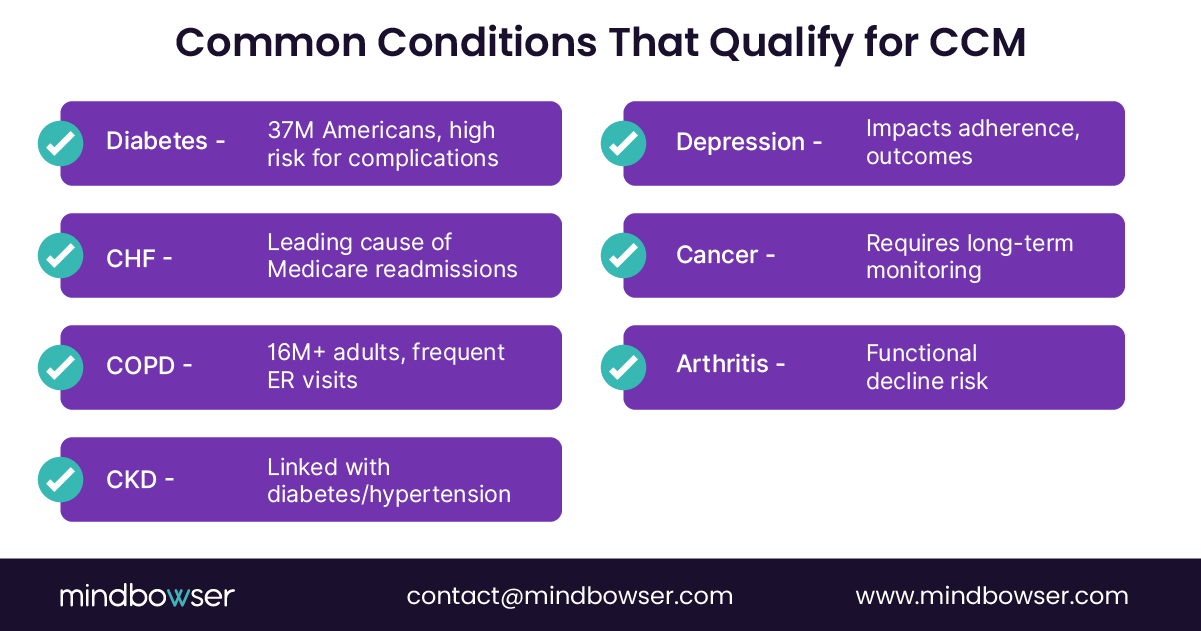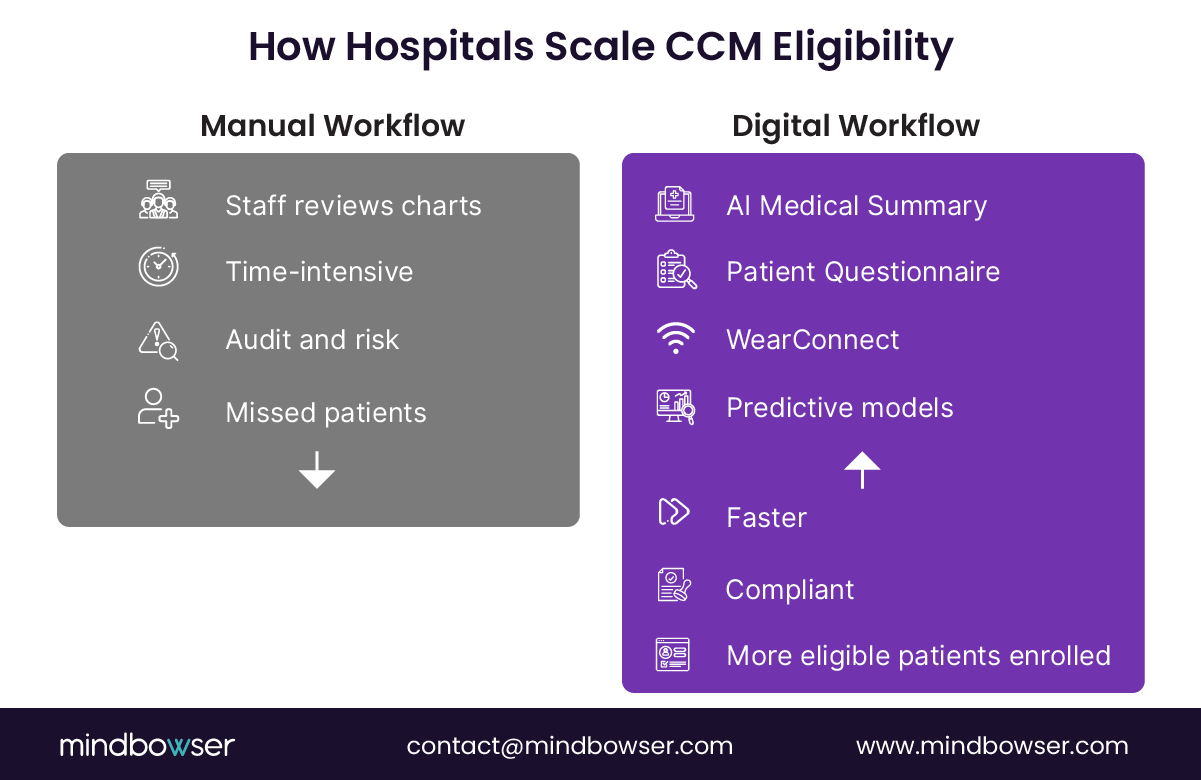CMS requires patients to have two or more chronic conditions expected to last at least 12 months. The most common qualifying diseases include diabetes, congestive heart failure, and COPD. Hospitals assess eligibility through structured workflows, and leading organizations use digital tools and automation to scale checks, ensure compliance, and maximize reimbursement.
Eligibility is the foundation of a successful Chronic Care Management (CCM) program. Without accurate patient identification, hospitals risk billing errors, denied claims, and missed opportunities for revenue and improved outcomes.
The Centers for Medicare & Medicaid Services (CMS) defines eligibility simply but firmly: patients must live with two or more chronic conditions, expected to persist for at least 12 months, that place them at significant risk of decline or acute episodes. This definition drives both compliance and the delivery of care.
The scale of need is enormous. 60% of U.S. adults live with at least one chronic condition, and nearly two-thirds of Medicare beneficiaries manage two or more. That makes eligibility not a niche exercise but a population health imperative.
For hospitals and digital health startups, correctly identifying and enrolling patients is not only about compliance. It is about aligning care management with reimbursement streams, engaging patients who are most in need, and ensuring that programs deliver measurable outcomes. In short, eligibility is where financial sustainability and clinical impact meet.
The Centers for Medicare & Medicaid Services sets clear criteria for participation in Chronic Care Management. Patients must have two or more chronic conditions that are expected to last at least 12 months or until the end of life. These conditions must pose a significant risk of death, acute exacerbation, or functional decline if not carefully managed.
This standard ensures that CCM services focus on patients who require ongoing care coordination rather than those with short-term or self-limiting health issues. The threshold of two chronic conditions reflects the reality that multi-morbidity is a primary driver of hospitalizations, readmissions, and costs in Medicare populations.
Related read: CCM Billing 2025: Codes, APCM & ROI
The eligibility rules carry weighty implications for hospitals, physician groups, and digital health platforms:
Hospitals that treat eligibility as a compliance formality often find themselves struggling with denied claims and operational inefficiencies. Those that approach eligibility as a strategic process, backed by technology and clear workflows, can scale programs with confidence while protecting both revenue and patient outcomes.
Related read: CCM Audit Risk & Protection: A Compliance Playbook for 2025

When most providers think of CCM eligibility, three conditions stand out as the most common qualifiers:
These three diseases represent the largest patient pools for CCM programs, but they are not the only ones that qualify.
Beyond the “big three,” CMS eligibility extends to many other conditions that meet the duration and risk criteria:
This breadth underscores the fact that CCM is not limited to one or two specialities. It is a cross-cutting service that touches primary care, cardiology, pulmonology, nephrology, oncology, and behavioral health.
Unlike other CMS programs that publish rigid disease lists, CCM relies on clinical discretion. Providers are empowered to decide whether a patient’s conditions pose a significant risk of death, acute exacerbation, or functional decline. This provides care teams with the flexibility to include patients with less common conditions, as long as the documentation supports the decision.
For example, an elderly patient with diabetes, hypertension, and moderate arthritis may not appear as high risk on paper. Yet a provider can document that the combination of conditions impairs mobility, increases fall risk, and makes hospital visits more likely. That patient is fully eligible for CCM enrollment.
A case example comes from one hospital that partnered with a digital health company to build enrollment strategies for multi-morbid elderly patients. Using structured workflows and patient engagement tools, the team identified patients with multiple qualifying conditions and enrolled them into CCM. The result was higher capture of eligible patients and improved reimbursement consistency (reference: TodayHealth).
In short, CMS provides the framework, but it is the provider’s judgment and documentation that determine eligibility. Hospitals that combine strong clinical protocols with digital tools can maximize both patient impact and financial sustainability.
Identify eligible patients faster, boost reimbursements, and stay fully compliant with Mindbowser’s intelligent automation and care management solutions.
The first step in any CCM program is identifying which patients qualify. Hospitals rely on structured assessment workflows that combine clinical data with staff review:
Hospitals that standardize this triage process reduce the risk of enrolling ineligible patients and missing eligible ones.
Once eligibility is confirmed, the focus shifts to enrolling patients into CCM. This process requires careful documentation and patient engagement:
Hospitals that make enrollment seamless for both staff and patients typically see stronger participation rates and higher monthly reimbursements.
As CCM programs grow, manual eligibility checks quickly become unsustainable. To scale, hospitals are turning to digital solutions that automate large parts of the workflow:

These digital tools not only accelerate the process of finding eligible patients but also reduce the risk of missed revenue and denied claims. Hospitals that adopt them are better positioned to expand CCM services without adding staff burden.
Related read: Custom CCM Software for Scalable Care Delivery
Hospitals and digital health startups often find that eligibility is the single most time-consuming and error-prone part of a Chronic Care Management program. Mindbowser simplifies this challenge by bringing together automation, integration, and proven ROI.
Mindbowser deploys workflows like the AI Medical Summary and Patient Questionnaire Form to streamline eligibility checks. Instead of sifting through charts manually, these tools automatically compile patient histories and capture structured data that aligns with CMS requirements. This enables hospitals to identify qualifying patients more quickly and accurately.
A strong eligibility workflow must be followed by a care plan that meets compliance standards and patient needs. Our CarePlan AI reduces coordination delays by gathering patient goals and preferences through simple chat or voice prompts. Hospitals using CarePlan AI report a 37% higher patient understanding of their care plan and a 42% reduction in coordination delays.
Eligibility does not stop at diagnosis codes. Many chronic patients generate valuable data through laboratory tests, vital signs, and connected devices. With HealthConnect CoPilot and WearConnect, Mindbowser integrates this information directly into the EHR. These integrations ensure that ICD-10 codes, lab values, and RPM feeds appear in a single workflow, making it easier for clinicians to validate eligibility and enroll patients.
Technology alone is not enough; programs must deliver results. In one case, we implemented an integrated care optimization suite that unified EHR, claims, and social data. By automating workflows and strengthening care coordination, the organization achieved a 52% reduction in readmissions and avoided over 250,000 inpatient days. This demonstrates how structured eligibility and care coordination drive both compliance and measurable financial impact.
Mindbowser positions hospitals and startups to achieve similar results by aligning patient eligibility with scalable workflows, predictive analytics, and seamless integration across systems.

Eligibility is more than a regulatory requirement. It is the entry point to effective Chronic Care Management. By identifying the right patients, hospitals and digital health leaders protect themselves from audit risk, capture sustainable reimbursement, and deliver meaningful improvements in patient outcomes.
The data is clear: two-thirds of Medicare beneficiaries already live with multiple chronic conditions. For these patients, CCM provides the coordination and monitoring that reduces hospitalizations and strengthens long-term health. For providers, it represents a critical revenue stream in a healthcare system shifting toward value-based care.
Hospitals and startups that continue to rely on manual chart reviews risk falling behind. Those that embrace automation, structured workflows, and data integration will find that eligibility checks become a driver of growth rather than a bottleneck. Mindbowser helps organizations reach this future by combining compliance with measurable ROI, ensuring CCM programs are built to last.
Patients qualify if they have two or more chronic conditions such as diabetes, congestive heart failure, COPD, chronic kidney disease, or depression. The conditions must be expected to last at least 12 months and place the patient at risk of decline or acute exacer of their condition.
Yes. Medicare does not restrict eligibility to a fixed list of conditions. Providers determine patient eligibility based on CMS criteria for duration and risk, and must document their clinical judgment accordingly.
Hospitals typically use a combination of EHR diagnosis code searches, structured intake forms, and staff chart reviews to inform their decision-making process. Increasingly, organizations are turning to digital tools such as AI summaries and predictive analytics to accelerate the process and improve accuracy.
Yes. CMS requires patients to provide verbal or written consent before enrollment. Providers must also educate patients about the scope of CCM services and any applicable cost-sharing obligations, and record this documentation in the EHR.
Automation plays a central role. AI-generated medical summaries, digital questionnaires, and RPM integration enable hospitals to identify qualifying patients efficiently and quickly. These tools reduce manual review time, lower compliance risk, and ensure that more eligible patients are captured and enrolled.

We worked with Mindbowser on a design sprint, and their team did an awesome job. They really helped us shape the look and feel of our web app and gave us a clean, thoughtful design that our build team could...


The team at Mindbowser was highly professional, patient, and collaborative throughout our engagement. They struck the right balance between offering guidance and taking direction, which made the development process smooth. Although our project wasn’t related to healthcare, we clearly benefited...

Founder, Texas Ranch Security

Mindbowser played a crucial role in helping us bring everything together into a unified, cohesive product. Their commitment to industry-standard coding practices made an enormous difference, allowing developers to seamlessly transition in and out of the project without any confusion....

CEO, MarketsAI

I'm thrilled to be partnering with Mindbowser on our journey with TravelRite. The collaboration has been exceptional, and I’m truly grateful for the dedication and expertise the team has brought to the development process. Their commitment to our mission is...

Founder & CEO, TravelRite

The Mindbowser team's professionalism consistently impressed me. Their commitment to quality shone through in every aspect of the project. They truly went the extra mile, ensuring they understood our needs perfectly and were always willing to invest the time to...

CTO, New Day Therapeutics

I collaborated with Mindbowser for several years on a complex SaaS platform project. They took over a partially completed project and successfully transformed it into a fully functional and robust platform. Throughout the entire process, the quality of their work...

President, E.B. Carlson

Mindbowser and team are professional, talented and very responsive. They got us through a challenging situation with our IOT product successfully. They will be our go to dev team going forward.

Founder, Cascada

Amazing team to work with. Very responsive and very skilled in both front and backend engineering. Looking forward to our next project together.

Co-Founder, Emerge

The team is great to work with. Very professional, on task, and efficient.

Founder, PeriopMD

I can not express enough how pleased we are with the whole team. From the first call and meeting, they took our vision and ran with it. Communication was easy and everyone was flexible to our schedule. I’m excited to...

Founder, Seeke

We had very close go live timeline and Mindbowser team got us live a month before.

CEO, BuyNow WorldWide

Mindbowser brought in a team of skilled developers who were easy to work with and deeply committed to the project. If you're looking for reliable, high-quality development support, I’d absolutely recommend them.

Founder, Teach Reach

Mindbowser built both iOS and Android apps for Mindworks, that have stood the test of time. 5 years later they still function quite beautifully. Their team always met their objectives and I'm very happy with the end result. Thank you!

Founder, Mindworks

Mindbowser has delivered a much better quality product than our previous tech vendors. Our product is stable and passed Well Architected Framework Review from AWS.

CEO, PurpleAnt

I am happy to share that we got USD 10k in cloud credits courtesy of our friends at Mindbowser. Thank you Pravin and Ayush, this means a lot to us.

CTO, Shortlist

Mindbowser is one of the reasons that our app is successful. These guys have been a great team.

Founder & CEO, MangoMirror

Kudos for all your hard work and diligence on the Telehealth platform project. You made it possible.

CEO, ThriveHealth

Mindbowser helped us build an awesome iOS app to bring balance to people’s lives.

CEO, SMILINGMIND

They were a very responsive team! Extremely easy to communicate and work with!

Founder & CEO, TotTech

We’ve had very little-to-no hiccups at all—it’s been a really pleasurable experience.

Co-Founder, TEAM8s

Mindbowser was very helpful with explaining the development process and started quickly on the project.

Executive Director of Product Development, Innovation Lab

The greatest benefit we got from Mindbowser is the expertise. Their team has developed apps in all different industries with all types of social proofs.

Co-Founder, Vesica

Mindbowser is professional, efficient and thorough.

Consultant, XPRIZE

Very committed, they create beautiful apps and are very benevolent. They have brilliant Ideas.

Founder, S.T.A.R.S of Wellness

Mindbowser was great; they listened to us a lot and helped us hone in on the actual idea of the app. They had put together fantastic wireframes for us.

Co-Founder, Flat Earth

Mindbowser was incredibly responsive and understood exactly what I needed. They matched me with the perfect team member who not only grasped my vision but executed it flawlessly. The entire experience felt collaborative, efficient, and truly aligned with my goals.

Founder, Child Life On Call

The team from Mindbowser stayed on task, asked the right questions, and completed the required tasks in a timely fashion! Strong work team!

CEO, SDOH2Health LLC

Mindbowser was easy to work with and hit the ground running, immediately feeling like part of our team.

CEO, Stealth Startup

Mindbowser was an excellent partner in developing my fitness app. They were patient, attentive, & understood my business needs. The end product exceeded my expectations. Thrilled to share it globally.

Owner, Phalanx

Mindbowser's expertise in tech, process & mobile development made them our choice for our app. The team was dedicated to the process & delivered high-quality features on time. They also gave valuable industry advice. Highly recommend them for app development...

Co-Founder, Fox&Fork
